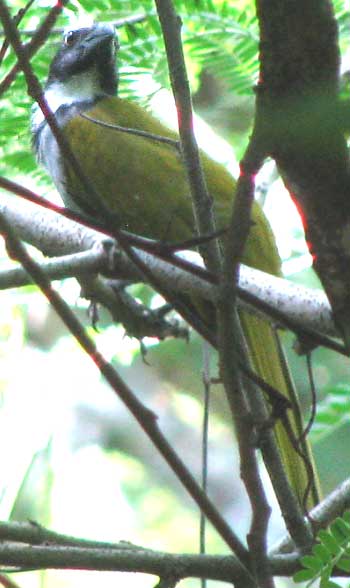Excerpts from Jim Conrad's
Naturalist Newsletter
from the March 3, 2008 Newsletter written in the community of 28 de Junio, in the Central Valley 8 kms west of Pujiltic, elev. ~700m (2300ft), ~N16.331°, ~W92.472°; southeastern Chiapas state, MÉXICO
SALTATORS

These mornings if you walk on the tree-shaded dirt trail down between the irrigated cornfields and pastures or wander the fire-ravaged, scrubby slopes and woods edges, one bird seems to be making more noise than all the others. "Noise" isn't a nice way to describe a birdcall that must constitute heartfelt and lucid communication to the bird, but if you'd hear it you'd understand.
Typically the calls are of two qualities. The noisiest is a loud, sharp, smacking or squeaking sound like what you get screwing the palm of your hand over a wet balloon -- CHOWK! or CHEUK! The other sound is a "gruff, accelerating, rolling laugh or chortling chatter," as Howell describes it. If you're bird- listening more than bird-watching you get the impression that the most conspicuous bird around here is the one making these sounds. The birds are saltators -- Black-headed Saltators, SALTATOR ATRICEPS, to be exact.
Thinking in terms of taxonomic affinities, Howell describes saltators as "fairly plain tropical grosbeaks of forest edge and second growth." Genetically they almost may be grosbeaks, but their beaks aren't nearly as oversized-looking at those of Rose-breasted or Evening Grosbeaks. To me saltators possess the size, shape and beak dimensions of towhees more than grosbeaks.
Mexico is home to three saltator species but around here I've only seen the Black-headed one, which is distributed from Mexico's central Gulf lowlands south to Panama. Our Black-headed species is easy to identify because it looks like a pea-green-backed, gray breasted towhee with a black head, and with a diamond-shaped, white throat-patch completely surrounded by a black border. Typically three to five birds fly around excitedly smacking and chortling.